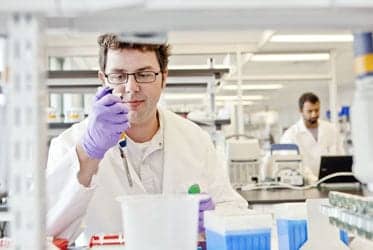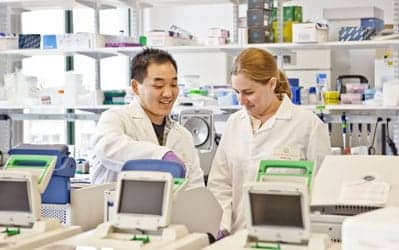Relies on a LIMS for integrating lab, clinical, and EMR data
BY: TRISH MEEK
 |
| Trish Meek is director of product strategy for Life Sciences, Thermo Fisher Scientific, Philadelphia. |
Founded by world leaders in genome technology, cancer biology, and medical oncology, Foundation Medicine, Cambridge, Mass, is a cancer diagnostics company at the forefront of bringing comprehensive genomic analysis to routine cancer care. The company’s clinical laboratory services help physicians and their patients develop customized cancer treatment and therapy based on the tumor’s molecular subtype. Key to this process is Foundation Medicine’s next-generation sequencing (NGS) platform, which extracts relevant genomic information from small amounts of cancer tissue.
For decades, all cancer patients, regardless of their genetic background, the nature of their disease, or their overall health, have had three basic options for treatment: surgery, radiation therapy, and/or chemotherapy. While these therapies are often very effective, they are broad-sweeping treatments that attack both healthy and cancerous tissue and cells.
Companies such as this one, however, have ushered in a new era in patient care: The age of personalized cancer treatment. This emerging field of medicine offers physicians the opportunity to attack 
“The care of oncology patients is on the verge of being individualized,” says Michael Pellini, CEO, Foundation Medicine. “The molecular makeup of each tumor is going to drive personalized medicine. Our goal is to work with oncologists and pathologists, and do nothing short of transform cancer care. We want to change the way cancer patients are managed, not just in academic medical centers but in communities across the US and internationally.”
Challenging the Status Quo in Cancer Care
Though the company is working to revolutionize cancer care, battling cancer in this personalized manner also means the cancer’s diagnostic paradigm must change, and it requires new systems to manage the collection and distribution of diagnostic data among providers, physicians, and patients. In other words, to bring the concept of personalized medicine to life, life science technology and information technology have to evolve in parallel—and eventually become integrated.
The company is working to solve the life science technology piece of the equation. It has developed a clinical diagnostic test, called FoundationOne, which performs next-generation sequencing on a very small amount of genomic material. The test is used to develop a “molecular” blueprint of a patient’s tumor; the blueprint is then shared with the patient’s physician, who in turn uses it to outline relevant therapies, treatments, and/or clinical trials. The test is optimized to fit easily into the clinical workflow of a practicing oncologist, and it can be used with DNA samples as small as 50 ng.
Meanwhile, changes in information technology are an absolute necessity to support the company’s groundbreaking work. Research labs require software that can manage samples, integrate with internal 
Clinics, on the other hand, need logical, patient-centered ways to request tests and view results in the context of an organization’s administrative and business rules, and in ways that don’t violate regulations concerning data security and patient privacy. Clinics, clinical labs, and hospitals use Laboratory Information Systems (LIS) to handle the business side of diagnostic transactions, including requisition management and reporting. A clinical LIS also ensures that patient data is managed securely and with the appropriate privacy settings to keep a facility in compliance with HIPAA and CLIA regulations.
To further complicate matters, patient management also occurs in electronic medical record systems (EMRs). EMRs not only record and store all information associated with a patient, from a physician’s notes about a medical visit to medication history to medical test results, they also serve as the physician’s main interface into the LIS.
To integrate these critical but disparate systems, Foundation Medicine chose Thermo Fisher Scientific’s clinical LIMS, a single informatics solution that combines the research-centered functionality of a traditional LIMS with capabilities typically found in a LIS. In addition to its ability to evolve as Foundation’s needs change, the LIMS assists with a series of state and national inspections designed to ensure the lab is processing clinical samples correctly. Such inspections include random selection of several patient samples, then a review of the entire paper trail, from requisition forms to training documentation forms (for anyone who handles the sample), maintenance documentation (for all equipment that touches the samples), reagent logs, control verification logs, and quality control (QC) documentation.
In the past, John Curran, the company’s lab manager, would have pulled these forms and records from a filing cabinet, but with the new LIMS he simply keys in an accession number and downloads what he needs. “Even though the LIMS is not a reagent management system, we can capture all the information as we process it, and I can get it all in one easy format at the end,” he says.
Integrating Life Sciences with IT
The company’s labs include adjoining rooms where samples are received, the DNA is extracted and manipulated, and the sequencing work is performed. The Nautilus LIMS ties the entire process together. “The informatics platform handles information management, aggregates information across the enterprise, and handles a very dynamic business process,” Curran says.
The clinical LIMS tracks the receipt of samples, and physicians can access a lab Web portal to receive information or order tests. “We send the shipping kit with bar codes, they apply the bar codes to the 
Next, the DNA is sized and normalized for hybrid capture, or the main portion of the testing. The company uses proprietary RNA baits to capture the genomic content; this material is then normalized for sequencing. The informatics team processes the sequence data and performs variant analysis; the detected alterations are fed back to the knowledge base, which in turn correlates the results to medical and scientific information. The final result report is delivered to the physician through the lab Web portal—ideally, no more than 14 days after the test was ordered.
The report summarizes the key mutations, relevant drugs, and clinical trials. Although the company can’t recommend a specific undertaking—in large part because it doesn’t have all the patient’s information—it can supply critical information for the physician. “We can’t recommend a particular action, but we can say, ‘Here are the genomic alterations and what they mean for this patient,’ ” says Mary Pat Lancelotta, the company’s director of strategic marketing. “Based on an exhaustive search of the literature, here are the therapeutic agents and clinical trials that you and your patient could consider. We’re giving physicians a fully informative genomic profile as a tool to help them make the next treatment decision with their patient.”
What the Future Holds
The disparate systems traditionally used by labs and clinics have obstructed the absolutely necessary, unbroken information stream that must exist in order to revolutionize patient care. A clinical LIMS is a natural extension of the clinical diagnostics market’s need for a streamlined, end-to-end informatics solution that follows the patient from the point of disease testing through results’ analysis, diagnosis, and treatment so that physicians can use the latest molecular tests, such as those being developed at Foundation Medicine, to deliver advanced, personalized care, says Dave Champagne, vice president and general manager for Informatics, Thermo Fisher Scientific, Boston.
And, as groundbreaking life science organizations continue to search for ways to innovate, the informatics tools that support them will evolve as well. It’s not just about making the lab run better and faster—it’s about finding entirely new ways of approaching a scientific question or tackling a therapeutic problem.
Foundation Medicine’s Pellini agrees with that goal. “The more cancers we sequence, the more information we’ll have to mine—and the more information we’ll need to find a way to mine. There’s no telling what we’ll find.”
Trish Meek is a contributing writer for CLP. For more information, contact Editor Judy O’Rourke, [email protected].
| Technical Details of Thermo Fisher’s Clinical LIMS Solution |
| • A physicians’ Interface provides a secure Web-based interface for submitting test requests to the lab, tracking sample progress, and accessing published patient reports. The Lab Web Portal features an integrated dashboard with tailored KPI alerts, on-demand querying, and prepackaged reports. • Patient management functionality facilitates comprehensive patient clinical record tracking, including insurance information, consent information, family and medical history, clinical notes, and testing results history. All Protected Health Information (PHI) is stored and managed in compliance with the privacy and security rules of HIPAA. • Clinical vocabularies and health level 7 (HL7) messaging supports CLIA-mandated exchange of laboratory information between clinical laboratories and external partners. • The Clinical LIMS supports compliance with CLIA and 21 CFR Part 11. All patient reports are stored in a read-only format (PDF) and corrections or amendments to reports are handled in accordance with CLIA section 493.1291. • Configurable hierarchy manages data collected during the sample testing process and accommodates varying laboratory needs. The configurable hierarchy is integrated with chain-of-custody, location management, aliquot/derivative, and pooled sample tracking. • Biospecimen and plate management includes graphical workflows and plate editors, as well as built-in integration functionality that facilitates increased throughput and automation. • Instrument integration and automation includes robotics, next-generation sequencing, analyzers, etc, and facilitates standardization of processes and simplifies operations across the clinical network. |
| Advantages of Routine Clinical Sequencing |
| The implications of routine clinical sequencing are enormous. For starters, it will expand on the number of specialized cancer therapies that target gene variations; therapies have already been developed for specific mutations found in breast tumors as well as lung, colorectal, and pancreatic cancers. Routine clinical sequencing can also bring new pharmaceutical options to market faster, as fewer patients are required to prove the drug’s efficacy, and the collected data will be more closely targeted to the specific issue researchers are trying to address. Routine clinical sequencing also requires much smaller samples, in turn reducing the number of tests or procedures a patient must undergo. |




